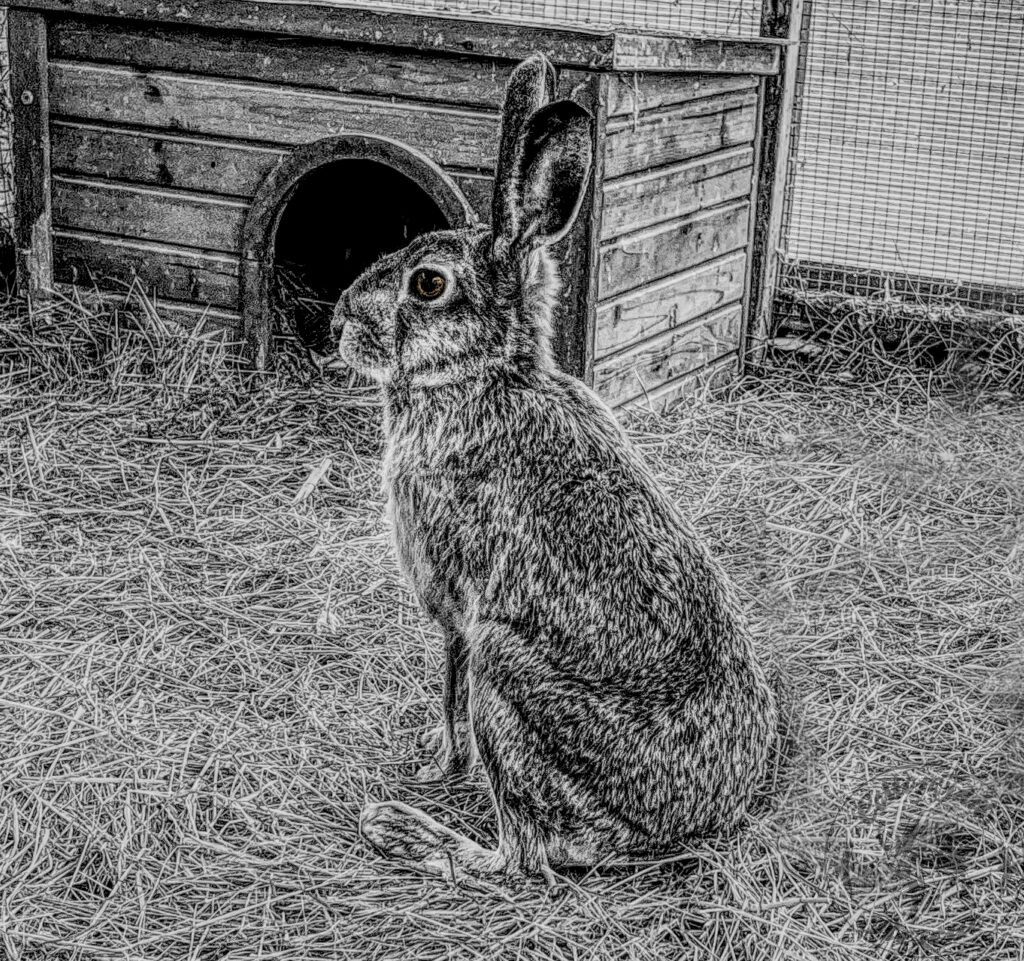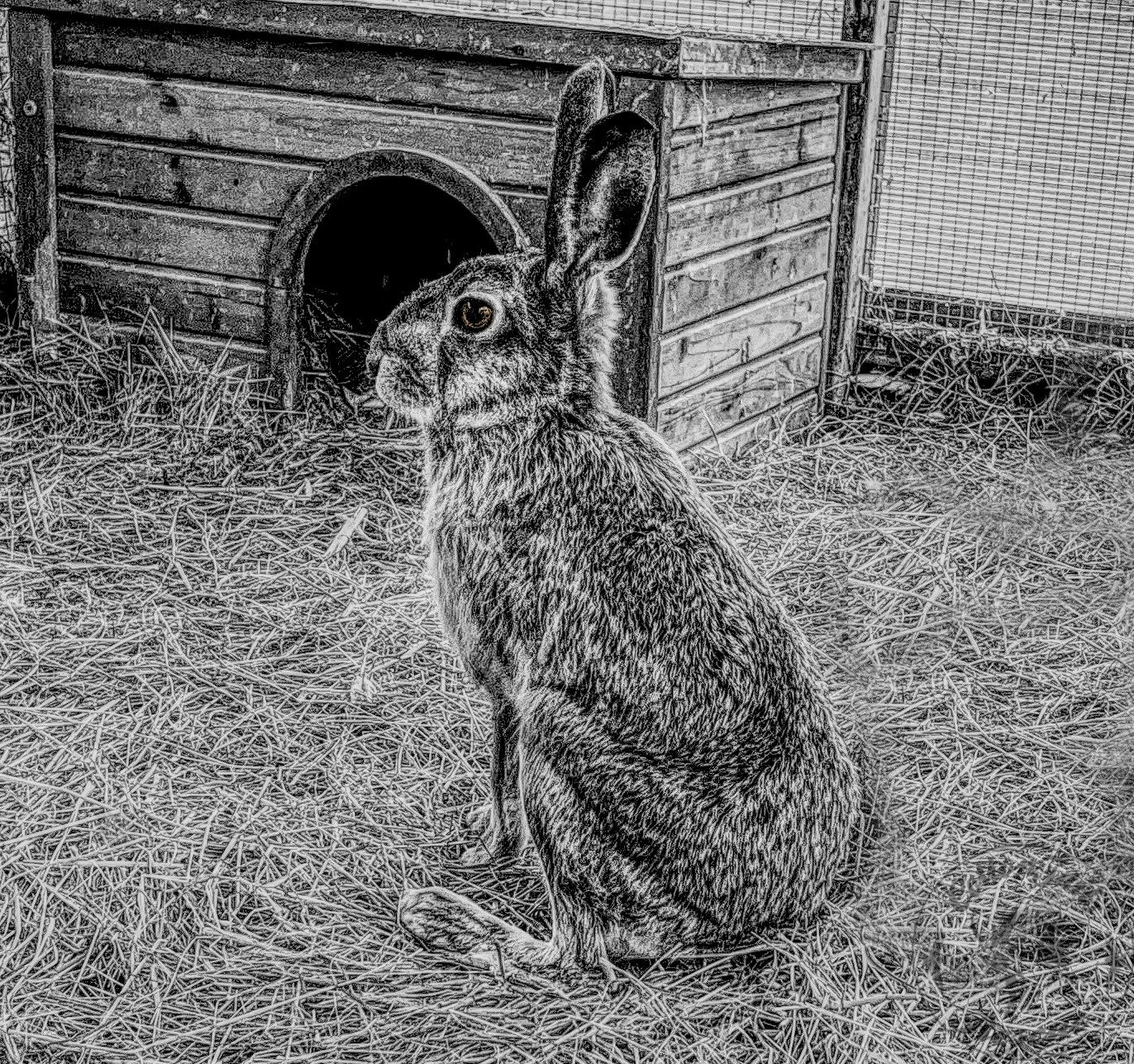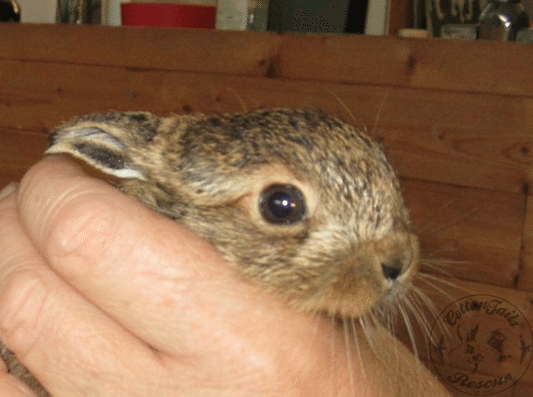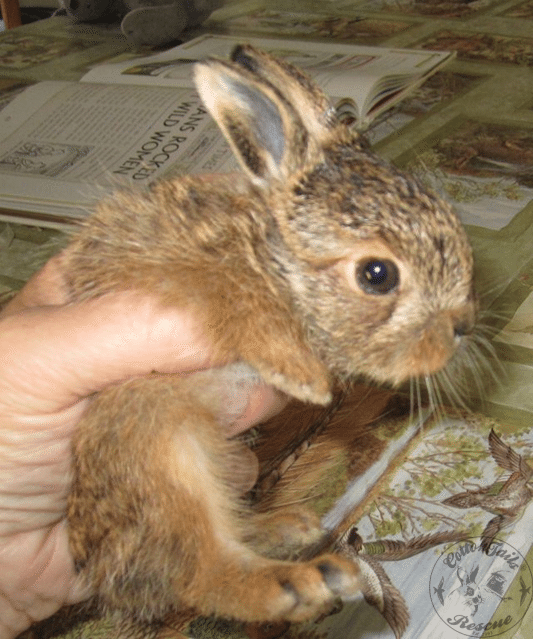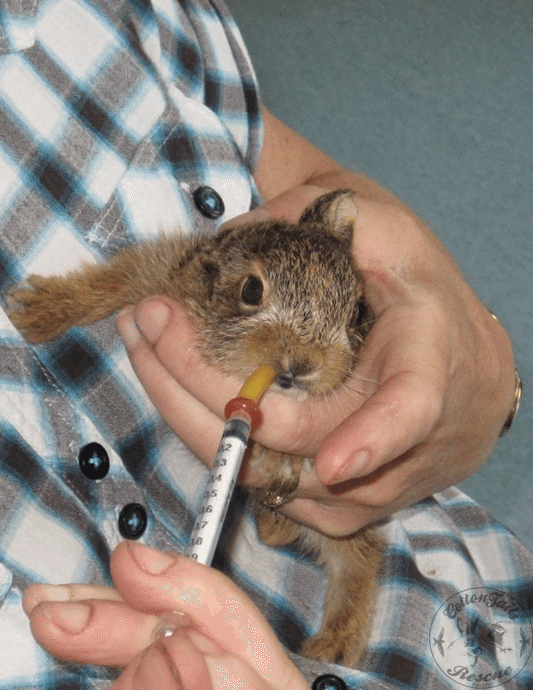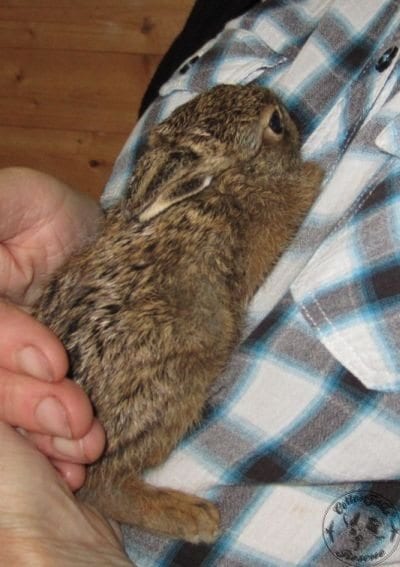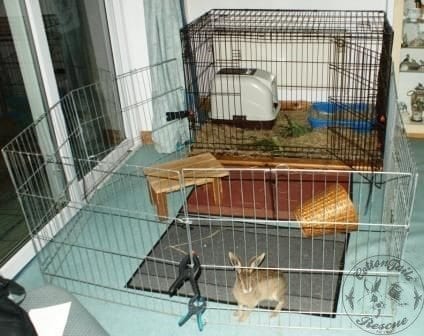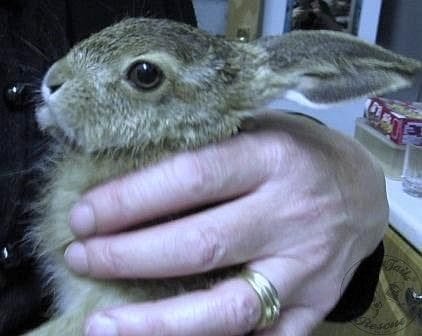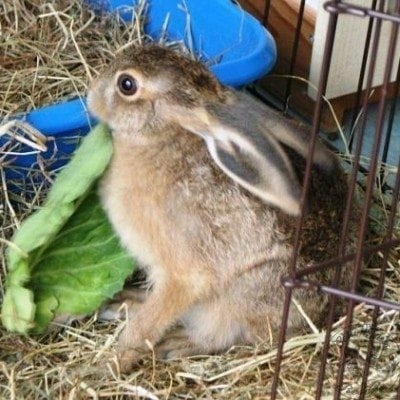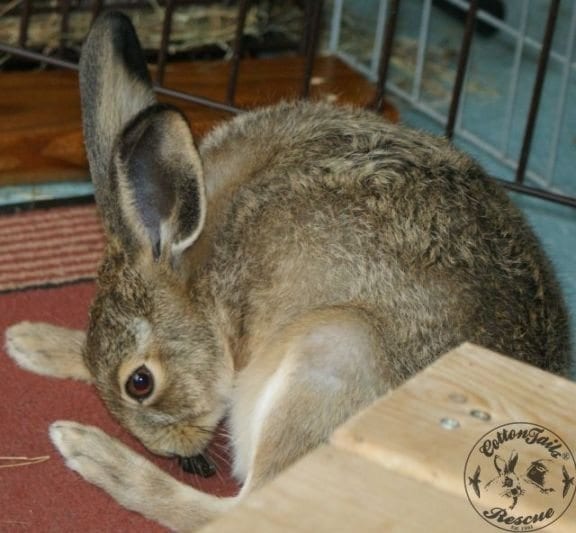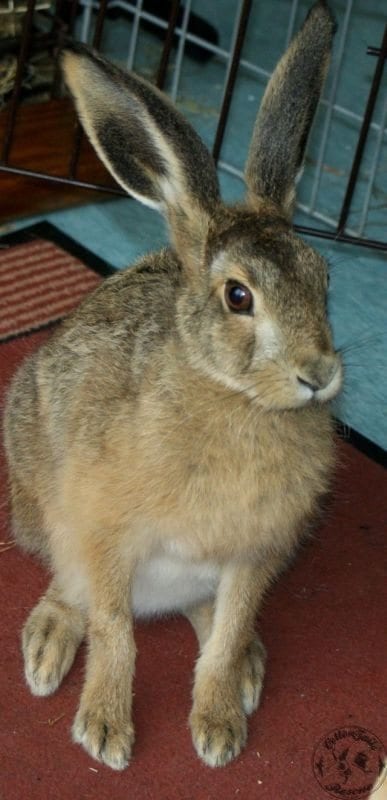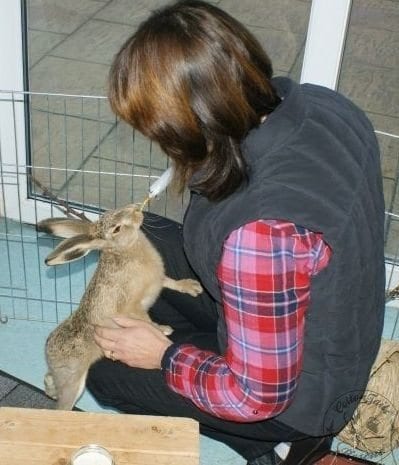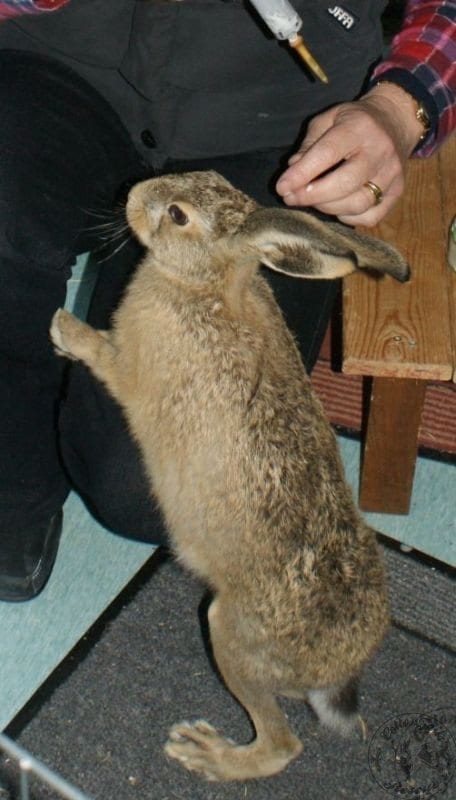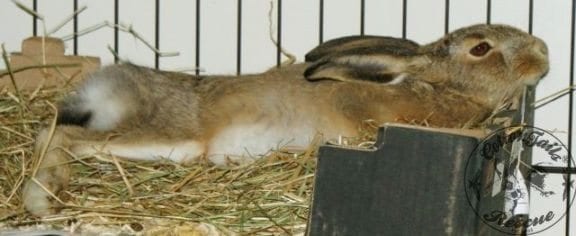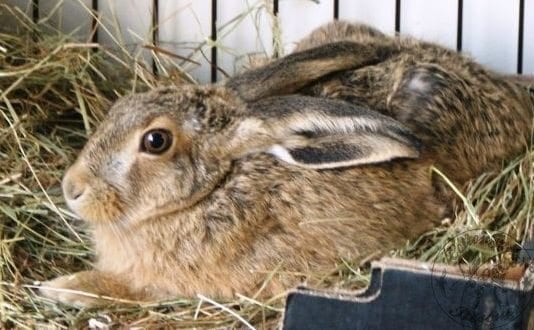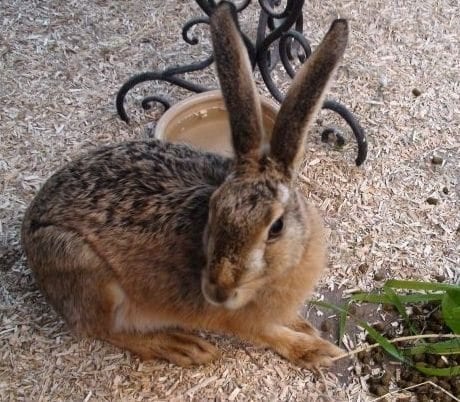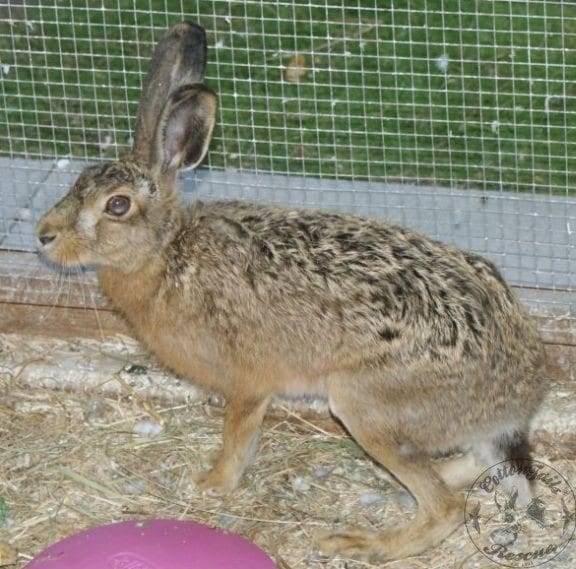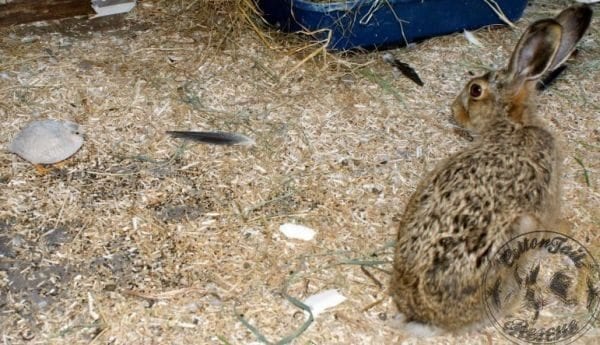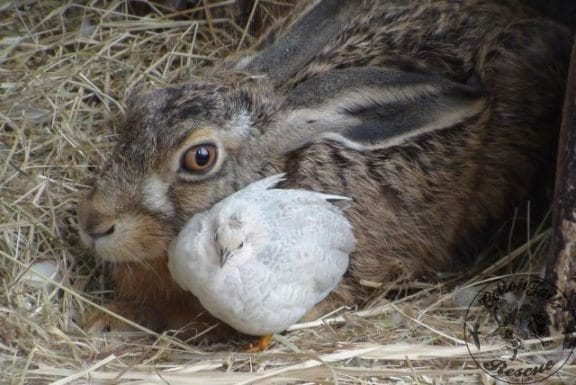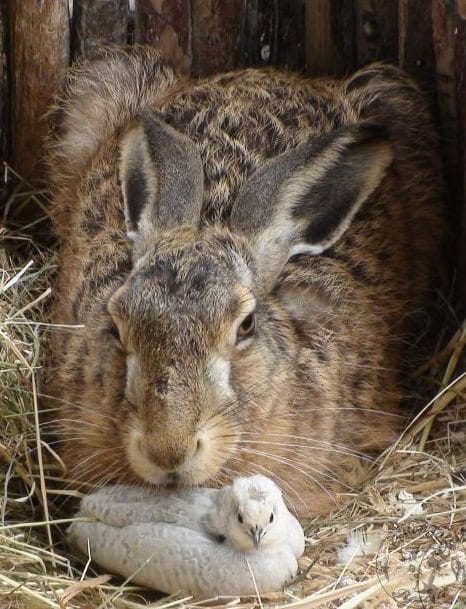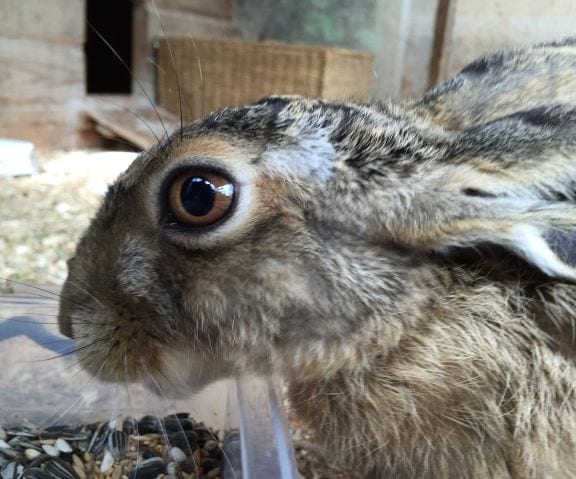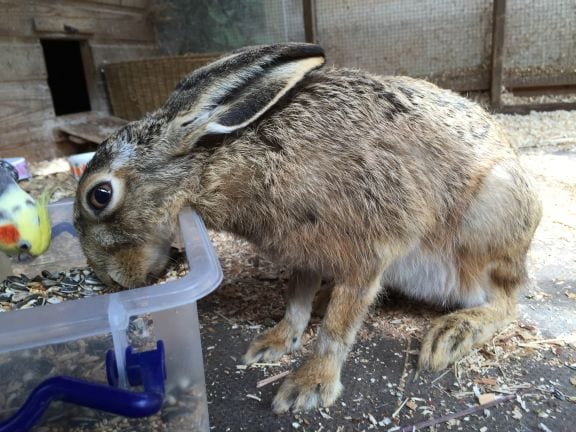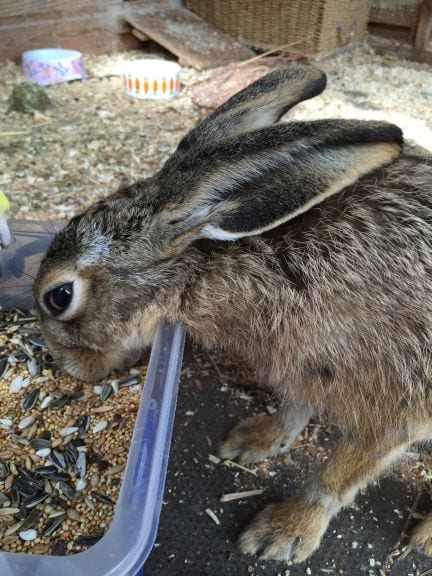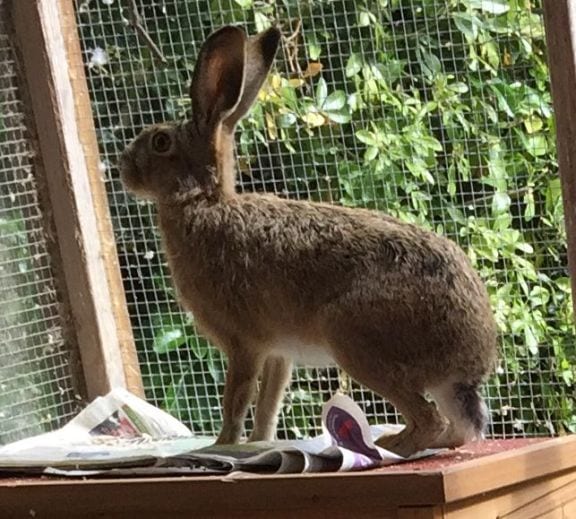It all started with a phone call, as these things often do. It was the 2nd of September, and as I checked the calls left on the answering machine, I came across an urgent message. It appeared that the callers’ partner was the pilot of a small plane that was kept in an airfield, the runway of which was a field with the grass kept short by an industrial-sized lawn mower. That day, the mower accidentally ran over a group of baby rabbits (or hares, the lady was unsure which), and she did not know what to do. The mower had struck four babies, two of whom were killed almost instantly, one ran away (perhaps injured, perhaps not), and one stayed put in sheer terror, and it was this one that ended up in a box in the lady’s kitchen. She went to a local pet shop to find out what she should do with it and was advised to contact me here at CottonTails®.
By this stage, it was getting late, so I suggested the lady put the baby and box (lined with pulled grass) somewhere quiet and warm overnight and bring it to me in the morning if it was still alive. I did not expect the doorbell to ring, as most cases like this sadly pass away from shock within hours. I was also expecting a young rabbit, as I have only once had a brown hare come into the rescue in almost 20 years of running CottonTails®, which was handed in by someone who had accidentally hit it with their car. That one lasted about 20 minutes, and I could do nothing.
The following day arrived, and, to my surprise, the lady did indeed turn up with it in the boot of the car. I decided to examine it there as a precaution before bringing it in, just in case it was a rabbit with myxomatosis, but when I cautiously opened the box, it was apparent immediately I was dealing with a hare after all, a tiny little leveret cowering in the corner!
I was aware that the leveret had not had any food for over 36 hours, so the first thing I had to do was prepare some kitten milk for him. I decided to use Beaphar Kitty Milk (a concentration of 1 flat scoop to 15mls cooled boiled water) and add the probiotic Avipro Plus (1 flat scoop to 100mls milk). I have hand-reared many baby rabbits over the years, so I was not surprised that the leveret only took a small amount during this first feed.
I settled him down in a small inside cage with a towel draped over the top to give him some security and placed him in the kitchen, where he was warm. Leverets are born fully furred with their eyes open, so they don’t need heated pads, unlike rabbits, who are born naked and blind and rely on mum’s pulled fur and their siblings to keep them warm. He weighed 128 grams and fitted easily into the palm of my hand.
Every couple of hours or so, I encouraged him to take a bit more milk, and by the end of the day, I was reasonably happy with how things were going. He seemed content but wary and ready to run if necessary!
Things continued like this for a couple of days, and by day 3 (6 days old), he was feeding well enough to cut the feeds down to 4 times a day. From the start, he was bedded on fresh hay, with grass and other vegetation available at all times. On days when the weather was good, I started to put him out in a secure run on the lawn in the garden for a couple of hours, which he thoroughly enjoyed. By this stage, he was living in a huge inside cage with a plastic house that he liked to sit in, and he could frequently be heard “drumming” with great enthusiasm with his front paws to make a comfortable patch in which to spend the day. When a wild hare rests, it will usually scrape away the vegetation and lie down on the bare earth, making a shallow depression known as a form.
I weighed Bambi again at seven days old, and he was 188 grams, a steady increase from when he first arrived. I started a new routine to let him have some extra exercise in the evening and filmed him running around the living room – it was plain to see how happy and relaxed he was by the cheeky way he explored and investigated everything.
By 13 days old, he weighed 269 grams, and I was starting to hope the way forward was clear. How wrong I was. When he was 14 days old, he began to show the first signs of gut stasis, and believe me, this is just as serious a condition in hares as it is for rabbits. I started treatment immediately, but there was something I had not taken into account – the problem of injecting a wild leveret. Although very young baby rabbits (domestic or wild) resent having an injection, their behaviour is completely and utterly different from that displayed by a leveret. Even trying to find the right spot to administer the medication resulted in total panic, and the injection itself was almost impossible as he tried everything he could to get away. Even trying to wrap him to restrain his movements safely did not help his terror. I placed an order with the vet for the oral variety of the gut stimulant metoclopramide, and in the meantime, continued with pain relief, metoclopramide injection, gentle massage and a heated pad.
Worryingly, he then developed bloat (a common complication of gut stasis) off and on for the next three days, with his abdomen swollen and hard and him clearly in pain, but with frequent medication and hands-on tender loving care, he was holding his own. At 17 days old, the oral meds finally arrived, and by mid-morning, he seemed brighter and started to eat some grass, passing some tiny droppings covered with mucus. However, by midday, he had collapsed.
I worked relentlessly with him all afternoon and feared the worst, but by late evening, he appeared more comfortable and had spent a reasonable night. The following day, however, the gut stasis symptoms returned with a vengeance, and I was convinced he was about to die. I stepped up his medication and sat with him on my knee for a long time, gently running a heated massage gadget on his abdomen up and down, up and down, until his muscles relaxed and the medication started to ease his pain. By evening, he seemed better but had developed significant lameness in his left hind leg, and he couldn’t put any weight on it. I couldn’t understand this, as I knew he had had no accident, fall, or twist that could have caused any injury. On examination, it was clear that nothing was broken, and he had full mobility, but he just would not put his foot on the floor when moving around.
The next few days showed a continuation of his recovery, and in the meantime, I researched his symptoms. It appeared that he possibly had “Brown Hare Syndrome”, a usually fatal condition but one that leverets don’t often get as they have some immunity from their mum’s milk, something, of course, he had not had.
He was by then 25 days old, and I was starting to think positively again for his future when he suddenly collapsed flat on the floor, paws out sideways, heaving quickly and vigorously in his attempt to breathe, and very, very distressed. His membranes had turned blue, and it was clear he was about to die. It was one of those situations where you know you have nothing to lose by trying anything you can think of, so I started immediately with additional medication – anything that I felt may help – and placed him gently on his heated pad on the hay to let nature take its course.
To my utter amazement and joy, within 6 hours, he was fully recovered! I think it is likely he had had some kind of heart attack, possibly linked to his previous illness, so it was a minor miracle that he pulled through now. He certainly was proving to be a tough little character!
By this time, it was clear we had missed the boat as far as releasing the hare was concerned, as by then, the weather was getting cold, and due to his illness, he had not been hardened off outside as would have been necessary by this stage if release was to be a viable option. Also, due to all the handling and attention required to save his life, he was a bit too tame to make this feasible, at least in the short term. It was decided, therefore, that I had better set him up in accommodation that would suit him for the winter and, with my husband’s blessing, I erected a huge dog pen with a large run attached and positioned it in the kitchen by the window. Although our kitchen/dining room is big, this set-up took up a large chunk!
The hare was by this stage 26 days old and was not impressed with this sudden change in environment, but after sulking for an hour or two, he emerged from his “box”, a large hooded cat litter tray, to tentatively explore his new home. Within minutes, he was kicking up his heels and having a great time, checking every corner in case he had missed something important.
Despite pressure from the family, I finally gave in and allowed a name to be chosen for the hare. I had refused to do this beforehand as I was concerned he would not make it, but the proof of his resilience was there in front of me, and it just had to be done. I spent a while looking at him stretching his long, elegant, fawn-like limbs, and the name came to me immediately: “Bambi”! So Bambi it was.
Within a few days, I had established a routine with his day-to-day maintenance of cleaning and feeding, and he was still enjoying three feeds of milk a day, 100mls at a time, which is quite a volume for a small creature, but it was the highlight of his day. I gradually increased his vegetables so he had a large pile of spring greens, celery and broccoli every day, in addition to copious amounts of hay and his bottle feeds.
When he was about two months old, I started introducing an eggcup full of dried food once a day. I chose Burgess Light as it was high in fibre and low in protein, a good combination which I have found works very well with rabbits with delicate digestive systems. I soon had proof of something I was sure would be happening but had failed to see it myself – that of the process of coprophagy. This process is common in rabbits, guinea pigs, and other species, where the food goes around the digestive tract twice. Hence, the animal can digest every bit of nutrition properly by ingesting a soft type of droppings directly from the anus, chewing and swallowing them with clearly great enjoyment. I happened to be taking some photos of Bambi at the time, so I struck lucky, and the photos below illustrate the point nicely. If you look carefully at the lower photo, you will see the caecotroph about to be enthusiastically consumed!
If his release had been on the agenda, he would not have been given any dried food as it is vital for rabbits or hares that are to be released only to be given food that they would be able to find for themselves in the wild, but in the circumstances, this was not going to happen for several months at least.
Soon, he was actively seeking out the pellets, and it was apparent they were very much enjoyed, so much so that a rattle of the food box provoked a rapid response, with Bambi waiting impatiently at the side of the run.
As he was getting a big boy by now, I thought I had better start to cut back his milk feeds, and reduced them to two a day by the time he was four months old and once a day by five months old despite Bambi’s antics at night trying to persuade me to give him more! By this stage, he was taller than the run sides when he stood up on his hind legs and looked rather like a demented kangaroo when taking his bottle.
I got him down to 30mls once a day, and he stayed at this level for another month until I finally decided enough was enough and withdrew his nighttime feed completely. It took a few days for him to accept that this was how things would be, and I almost caved into his persuasive tactics, but I knew it was in his best interest to get him weaned properly. I replaced the milk feed with some grass and vegetables, so he still had something to look forward to, but you could tell he was not that impressed!
Although I realised that Bambi would be with us right through the winter, I hadn’t thought about where we would put the Christmas Tree, as it usually took pride of place precisely in the middle of where the run now stood. An intense family discussion took place, and it was decided to move the furniture around to make a new place for the tree so Bambi’s pen could stay where it was. This hare was starting to rule the roost! During the tree decorating process, he watched from his box with great interest, but to be honest, I think he thought we were all potty, and maybe he was right.
By this stage, Bambi had become very relaxed with life, spending a lot of time sprawled out in his litter box fastened tightly to the top of his “house” to stop it moving when he leapt into it at great speed, a frequent occurrence.
I came down one morning between Christmas and New Year and opened the curtains to find I was staring at Bambi staring at me, on the wrong side of the run fence! It appeared that he had somehow managed to climb up in the corner and over the top but then landed in the curtains, and the way the run was set up, he could not squeeze between them and the patio doors, so he had to sit there until rescued. I opened up the run, and he gratefully ran straight back in, pleased to be back home again. He did not attempt this manoeuvre again for a few weeks as I think it scared him, but in early February, he started to get restless and leaping over the top regularly. Once again, a family discussion took place, and it was decided for his safety to move him out into the large aviary outside as soon as the weather turned a bit milder. Within a week, he was safely settled in his new home, a 12-foot by 8-foot aviary with flight and inside area.
Although we placed his “house” in the aviary with him, he rejected it right from the start and took to lying low in the dark area during the day and coming out from dusk onwards. After a week or so, however, he decided he would prefer to snuggle down on a bed of hay in the corner of the open part of the aviary. Here, he would stay all day (apart from feeding time) until dusk, where again he would become active, mimicking the pattern he would have shown if he was wild.
Bambi shares the aviary with several birds, and all have accepted each other very well, even grazing together when a big pile of fresh grass and dandelions are placed on the floor. The only slight problem is that Bambi has developed a talent as a sneak thief, snaking his way inside the quail house to steal their seed! No matter what I did to make it difficult for him, he could often be seen with his back legs and bottom sticking out of the feeder while he slithered through the tiny doorway to eat his fill. I have now changed the design of the quail feeding house and made sure there is only just enough to feed the quail for 24 hours, and Bambi now seems to think there is not enough of a reward to take all the trouble to get his now significantly reduced snack.
I have not ruled out releasing Bambi if he starts to become restless and unhappy, but for now, he seems happy and content, even letting us stroke him for a short while whilst he has his evening meal of grass, dandelions and some pellets. It is always on his terms, however, and he is swift indeed to tell you off if you hang around for too long by either drumming on your legs with his front paws or even biting, but it is more a hard nip than a very aggressive bite, more a warning than an actual attack.
I feel very privileged to have had this adventure with Bambi, and I have learnt a lot in the process. Strangely, although Bambi looks remarkably like a rabbit in many ways, he is, in reality, totally different. Hares do not burrow and rarely nibble on non-food items, so from that point of view, they are a pleasant change compared to the destructive behaviour of a rabbit, especially in the house. Being solitary creatures, they do not seem to need the attention of another hare, unlike rabbits, who love living in compatible pairs or groups and enjoy being groomed by their companions. One thing is certain: having a hare in the house has been quite an experience!
The film below was taken in May 2013 when Bambi was eight months old.
Some facts about Hares:
- Scientific name: Lepus europaeus
- Female = a Jill, male = Jack
- The European hare is the fastest land mammal in the UK.
- Hares can have between 2 and 4 litters of young a year, usually between February and September. The young are born in the open, with a full coat of fur and open eyes.
- The young hares are known as leverets, and each one in a litter will be left in a separate form of its own.
- They can leave their birthplace very soon after they are born.
- Hares protect themselves in their forms by lying as still as a statue, tucked in close to the ground with their ears pressed flat along their backs
- A hare will not move until the last minute before it is discovered, as its best defence lies in stillness and camouflage.
- Hares can run incredibly fast, up to 35 miles per hour, although this is saved for escape, and they generally lope along at a much more leisurely pace.
- In March and April, hares can often be seen leaping about and having wild chases with each other. They will sometimes also have ‘boxing matches’, standing up on their hind legs, face to face and boxing with each other. This peculiar spring behaviour is where the expression ‘Mad as a March Hare’ comes from, as it usually involves unreceptive females fending off amorous males.
- Hares are herbivores, eating grass and other plants.
- The leverets may be eaten by predators such as foxes, buzzards and owls, but the adults are generally quick enough to escape most enemies.
- Leverets are particularly vulnerable to cutting machinery in grass fields.
- Baby hares or leverets receive very little care from their mother, so the babies lie very still in their nests, called scrapes or ‘forms’, to avoid being seen by predators.
- For about the first month of their lives, the leverets come together at sunset to be fed by their mother. Hare milk is very high in fat and nutrients, so baby hares only need to be fed once a day. After about a month, they must learn to care for themselves.
- The Easter Rabbit, or Easter Bunny, as people sometimes call him, is an Easter Hare! In places in northwest Europe, like Germany, the Netherlands, Belgium and some other European mainland countries, he is still called the Easter Hare rather than the Easter Bunny.
Update: 9th July 2013 (10 months old):
Until yesterday, Bambi had been doing very well and seemed happy and content. However, I have spent much time today battling to save him. He has not been himself for a few days but has not shown any definite signs of anything specific. I noticed he was not as keen to come forward for his usual goodies. If he had been a rabbit, I would have started gut stasis treatment as a precaution, but being a wild hare, it is a different situation, as any manhandling can cause severe stress, which can be fatal. Last night, he was nibbling on some dandelions and grass, so I felt a bit happier, but this morning, it was clear he was in pain, so I decided I had to act regardless of the risk, so I gently scooped him up in a large bath towel and hung on for dear life as it was like holding on to a kangaroo! Hares feel very different from rabbits; they are not soft and cuddly but hard and leggy.
It took a good minute or two for him to stop struggling, and then I got a dose of Metacam into him (which he quite liked) before offering him a syringe of recovery mix with added probiotics and rehydration therapy. Much to my surprise, he took several syringes of this, and then I had to stop and get his gut stimulant injection over with, which went down like a lead balloon, as you can imagine. However, he seemed to forgive me as he took some more recovery mixture, and then I gently let him go onto the aviary floor again. He seemed brighter, so I left him to it. After a few hours, I checked on him again, only to find he had gone rapidly downhill. A repeat of the morning antics transpired, and once again, he rallied, enjoying a bit more recovery mixture and some grass. I have just returned this evening from the aviary, and I am pleased to report he seems much more relaxed, but I know we are not out of the woods yet. I desperately hope he pulls through, as he has become a family member, and we all love him dearly. Funnily enough, he has made friends with our last remaining Chinese quail, and the pair are often seen nose to beak or snuggling against each other contentedly. Bless!
10th July
Bambi seemed bright this morning, and when I went into the aviary, he was tucking into some green veg, which was a good sign. I decided not to catch him but to observe how things went, but within a couple of hours, it was clear he was not right, so I had to get the bath towel out again and administer the medications once again. He enjoyed several syringes of recovery mix, too, which was reassuring. He seems reasonably relaxed, and I have switched on the cooling fan to send air through the aviary as it is extremely hot again today.
13th July
I am glad to report that Bambi has pulled through and is back to his old self again. I hope he is not going to make a habit of this! Below are some photos I took today, including a couple with the quail, who is never far from Bambi’s side.
The film below was taken about a week before our little quail, Bambi’s dear friend, passed away due to old age. I found her still snuggled in between Bambi’s paws, her favourite place, and I take comfort from the knowledge she was warm, safe and content when she died. We shall all miss her as she was a plucky little bird, a real little character.
Attempt to bond Bambi with a Belgian Hare neutered female
I was well aware of the vast differences between hares and rabbits. Still, as Bambi enjoyed the little quail’s company, I thought it was worth trying him with a neutered female Belgian Hare, which, despite the name, is a type of rabbit. She looked and behaved more like a hare than a bunny, but I knew the social and behavioural differences meant I was trying to match two different species, so I had little hope of success. I filmed the process and have included the film below – it is interesting to watch, especially as a comparison between hares and rabbits.
Snorting!
July 2014 – Bambi is just under two years old now, and in the last couple of months, he has started making a snorting sound from time to time, usually if he is annoyed about something or if he is excited. I managed to capture this on film, and the clip is below.
April 2015 – A short piece of film taken at supper time!
Here is some film I took using my iPhone, filmed on 27th June 2015.
Here are some photos I took at the same time:
The film above was taken on Christmas day (2015), and I could not resist taking footage of Bambi enjoying his festive breakfast! He is now over three years old.
The film below was taken in September 2016, and Bambi is now over four years old.
I took this photo below earlier this year (2017) with Bambi being five years old, as the sun was catching his beautiful fur, making it shine like gold. I think the pattern and colouring of the fur on their backs can give them that golden shine when running in fields in the sunshine.
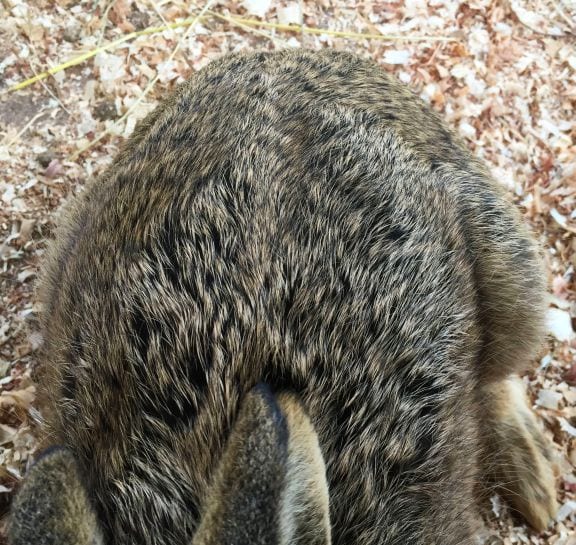
October 2017: Bambi is now five years old, and I took the following film to show how keen he still is to have his daily treat!
Here is a short film of Bambi, taken on 14th March 2018, with Bambi just over five and a half years old. Apologies for the poor light, but I filmed him enjoying his supper last night just as it started to get dark. He is very settled these days and has accepted his new friends – 4 of my elderly pigeons that crows were attacking, so they are now confined to the aviary for their safety. I have never seen crows be so vicious with pigeons, they obviously worked out they were old and doddery and easy pickings, but it does not mean I have to agree with nature which is why they are confined to barracks!
The film below was taken in June 2018 and is an interesting study on hare behaviour when faced with a pushy pigeon …
Here is a short film of Bambi waiting eagerly for breakfast, filmed in June 2019. He is almost eight years old (born in September 2012).
Here is a film of Bambi and friends, taken at the start of April 2020.
This film and photo were taken in 2022, and Bambi is now in his 10th year! He is showing no signs of age, although he has perhaps mellowed a bit as he is not so inclined to box me in the back of my knees!

October 2022: Bambi is now over 10 years old! He has just finished his Autumn moult, and I have made a short film briefly following him through the process.
The Final Curtain …

It is with a heavy heart that I have to bring this story to a close. At the grand age of 10 years and nine months, Bambi passed away during the night a few days ago, thankfully at home and in the place that he knew and loved for his whole life. We miss him terribly and are heartbroken, but we know that time will ease the pain, to be replaced with the many happy memories that he gave us. It has been a privilege to be part of his life, something none of us in the family will ever forget. Bambi, rest easy, you are running free at last.
